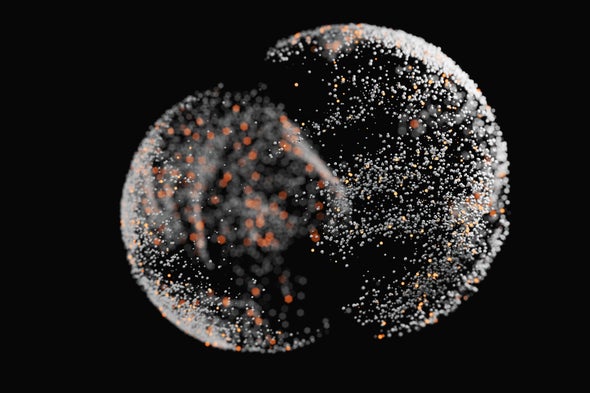New research attempts to discern how bizarre particles of strange matter form in the nuclei of atoms

A new physics result two decades in the making has found a surprisingly complex path for the production of strange matter within atoms.
Strange matter is any matter containing the subatomic particles known as strange quarks. “Strange” here refers, in part, to a profound remoteness from our everyday lives: strange matter only seems to show up in truly extreme circumstances such as high-energy particle collisions and perhaps the enormously dense and pressurized cores of neutron stars. Probing the details of strange matter’s emergence is part of a broader effort by nuclear physicists to understand the fundamentals of how subatomic particles form. In this particular case, a group of researchers focused on one variety of strange matter, called lambda particles.
“This data is the first time we study the lambda in the [atomic] nucleus, and we look at what we call hadronization, the process of producing hadrons,” says study co-author Kawtar Hafidi, associate laboratory director for physical sciences and engineering at Argonne National Laboratory.
Hadrons are subatomic particles that are made of quarks and subject to the strong force. This is the force that binds quarks together to make larger particles such as protons and neutrons and that holds those protons and neutrons within an atom’s nucleus. Lambda particles are baryons, which means they’re a type of hadron made of three quarks: one up quark, one down quark and one strange quark. The vast majority of quarks are of the up or down varieties, says Lamiaa El Fassi, lead author of the new study and an associate professor of experimental nuclear physics at Mississippi State University. Strange quarks are heavier, rarer beasts than their up and down siblings, and the particles they form are correspondingly far less stable, tending to decay very quickly.
The scarce, slippery nature of strange quarks is precisely what makes them so appealing for researchers, says Daniel Brandenburg, an assistant professor of physics at the Ohio State University, who was not involved in the new work. “Our naive picture of a proton and a neutron is that they involve up and down quarks,” he says. “So part of the reason that strange quarks are interesting is because, at least in this naive picture, they’re not there at the beginning. You have to create them somehow.”
Lambda particles have been studied before, but in the new paper, the researchers relied on a special process called semi-inclusive deep inelastic scattering to create them inside a nucleus. This involves shooting an electron beam at a nucleus, which transfers energy to the quarks within the protons and neutrons inside, stimulating lambda production.
Yet despite these elaborate efforts, the arcane laws of quantum mechanics dictate that, even here, the electrons do not interact directly with the quarks. Instead the impinging electrons release “virtual” photons, so called because they scarcely exist at all: these photons are reabsorbed by the quarks almost as fast as they are emitted. The resulting energetic kick can send quarks pinballing through the nucleus, where they combine with other quarks to create lambdas and other “composite” particles.
This subatomic alchemy took place at the Thomas Jefferson National Accelerator Facility way back in 2004. At the time, El Fassi was conducting separate research with the dataset, but she eventually chose to seek evidence of lambda particles within it as well. Teasing out the subtle signal of lambda decay—the particles are too short-lived for direct detection—required more than 10 years of effort. “It is a long journey,” El Fassi says. She and her colleagues reported their findings in the journal Physical Review Letters.
By studying the energy and momentum of the particles produced by the decaying lambdas, El Fassi and her colleagues could piece together exactly what happened to the freed quarks running rampant through the nucleus. Interactions with other subatomic particles sapped the quarks’ energy to varying degrees, and they experienced changes in momentum as they linked up with other quarks to form hadrons.
Most strikingly, the researchers saw differences between the production of lambda particles with high and low energies that suggest these particles sometimes form in an unexpected way. Instead of a virtual photon hitting one quark and freeing it to go find two new quarks to bond with, as theorists have long assumed, the virtual photon sometimes seemed to interact with a quark pair, known as a diquark. Likely composed of the mundane up and down quarks that are so plentiful in the nucleus, this diquark would then go in search of a third quark, ultimately bonding with a strange quark. When this happens, the result is a lambda particle. The findings not only reveal how these strange and unusual particles form, Brandenburg says. Because the particles’ final energies and momenta contain information about what they encountered on their journey through the nucleus, they can also help uncover what’s happening in the hidden hearts of atoms.
Not all physicists are convinced that this diquark hypothesis reflects how lambdas really form, however. There are alternative models that could explain the energy and momentum patterns the researchers observed, says Jen-Chieh Peng, a professor of nuclear physics at the University of Illinois at Urbana-Champaign, who was not involved in the new study. For example, he says, patterns of momentum transfer between particles that the researchers attribute to the diquark’s dynamics could instead be the result of a single quark picking up two quarks separately. That would mean the original “quark-by-quark” conception of how tripartite particles such as lambdas form is correct. “Their data is interesting but the interpretation, I think, is a very long shot,” Peng says.
Better measurements will likely settle the debate in the near future. The electron beam at Jefferson Lab is twice as powerful today as it was in 2004, El Fassi says, and new hadronization experiments are planned for next year. The Electron-Ion Collider, a particle accelerator now being planned at Brookhaven National Laboratory, will also be a powerful new tool for similar experiments, Brandenburg says.
“Because we’re still building it,” he says, “we can really fine-tune it for the measurements we know are important.”
ABOUT THE AUTHOR(S)

Stephanie Pappas is a freelance science journalist. She is based in Denver, Colo.
Note: This article have been indexed to our site. We do not claim legitimacy, ownership or copyright of any of the content above. To see the article at original source Click Here













